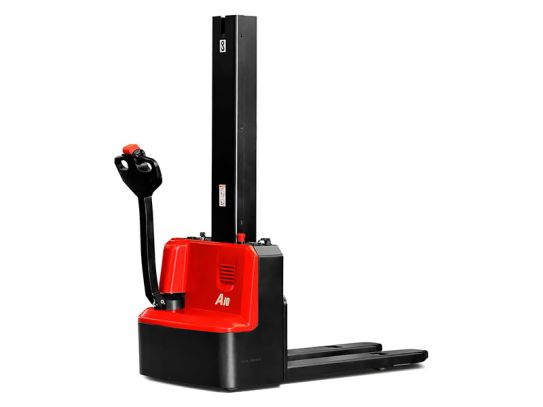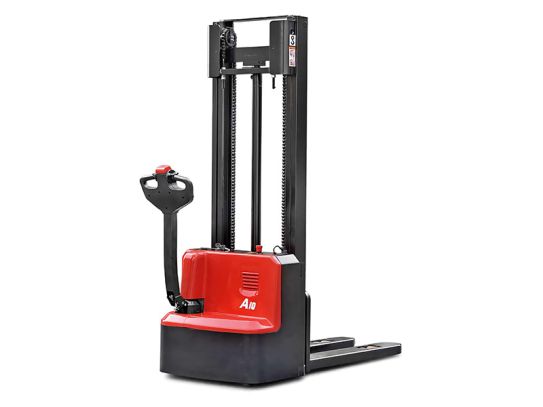Pallet Stackers
Upgrade your operations and improve safety with our reliable pallet stackers. Easily manoeuvre in tight spaces and efficiently stack pallets with our compact and user-friendly pallet stackers. Easy to use and built to last, our pallet stackers are here to help.
Are you tired of struggling to move and stack heavy pallets by hand? Our high-performance pallet stackers are here to help! With their powerful electric motors and advanced control systems, our pallet stackers make it easy to handle and store large quantities of goods and materials. Plus, our pallet stackers are built to last, with durable construction and a range of safety features to help prevent accidents and injuries. Don't waste any more time and effort on manual pallet handling - upgrade to one of our efficient and reliable pallet stackers today!
What Is a Pallet Stacker?
Our pallet stackers are a type of forklift that are designed specifically for the purpose of stacking pallets, which are large, flat platforms used for storing and transporting goods. Our pallet stackers typically have a pair of vertically adjustable forks that can be lowered onto the top of a pallet to lift it off the ground, allowing the operator to move the pallet to a different location and stack it on top of other pallets. Pallet stackers are commonly used in warehouses, distribution centres, and other facilities where large quantities of goods are stored and moved on pallets.
What Are the Benefits of Pallet Stackers?
There are several benefits to using a pallet stacker for handling and storing goods on pallets. Some of the key advantages include:
- Efficiency: Pallet stackers are designed to quickly and easily lift and move pallets, allowing workers to efficiently handle large quantities of goods. This can help to improve the overall productivity of a warehouse or distribution centre.
- Safety: Pallet stackers can help to reduce the risk of injury to workers by allowing them to avoid heavy lifting and other physically demanding tasks. This can help to create a safer work environment and minimise the risk of accidents and injuries.
- Versatility: Pallet stackers are versatile machines that can be used for a variety of tasks, such as stacking pallets, loading and unloading trucks, and moving goods around a warehouse. This makes them a valuable tool for any facility that handles large quantities of goods on pallets.
- Durability: Pallet stackers are built to withstand the demands of a busy warehouse or distribution centre, and are designed to be durable and long-lasting. This can help to minimise downtime and ensure that workers have the tools they need to efficiently handle goods on pallets.
How Do You Operate a Pallet Stacker?
Operating a pallet stacker typically involves the following steps:
- Start the pallet stacker and engage the forklift controls.
- Lower the forks onto the top of the pallet that you want to move.
- Use the controls to carefully lift the pallet off the ground.
- Move the pallet stacker to the desired location, using the controls to steer the machine and adjust the height of the forks as necessary.
- Lower the forks onto the ground or onto another pallet to stack the pallet.
- Repeat the process as needed to move and stack additional pallets.
It is important to always follow the manufacturer's instructions and safety guidelines when operating a pallet stacker, and to ensure that the machine is in good working order before using it.
Are There Any Safety Issues with Pallet Stackers?
Yes, there are potential safety issues with pallet stackers that workers and operators need to be aware of. Because pallet stackers are powerful machines that are used to lift and move heavy loads, they can pose a risk of injury if they are not used properly. To help prevent accidents and injuries, it is important for operators to be properly trained in the safe use of pallet stackers, and for workers to follow all safety guidelines and procedures when working with these machines. Some common safety issues associated with pallet stackers include:
- Overloading: Pallet stackers are designed to lift and move specific weights and sizes of pallets. If a pallet stacker is overloaded, it can become unstable and potentially tip over, causing injury to workers and damage to the equipment.
- Poor visibility: Pallet stackers often have limited visibility, which can make it difficult for operators to see other workers or objects in their path. This can lead to collisions and accidents.
- Improper use: If a pallet stacker is not used according to the manufacturer's instructions, it can be dangerous. For example, using a pallet stacker to lift or move something other than a pallet can cause the equipment to become unstable and potentially cause an accident.
- Maintenance: Pallet stackers require regular maintenance to ensure that they are in good working order. If they are not properly maintained, they can become unsafe to use and increase the risk of accidents and injuries.
It is important to use pallet stackers safely and to follow all safety guidelines and procedures to prevent accidents and injuries.
How Do I Maintain My Pallet Stacker?
To ensure that your pallet stacker remains in good working order and continues to operate safely, it is important to perform regular maintenance on the equipment. Some steps you can take to maintain your pallet stacker include:
- Follow the manufacturer's instructions for maintaining your specific model of pallet stacker. This will provide specific guidance on how to care for your equipment and ensure that it continues to operate properly.
- Perform regular inspections of your pallet stacker. Check for signs of wear or damage, such as loose or broken parts, leaks, or other issues. If you notice any problems, address them promptly to prevent them from becoming more serious.
- Keep your pallet stacker clean and free of debris. Dirt and debris can interfere with the operation of the equipment and increase the risk of accidents.
- Lubricate moving parts as recommended by the manufacturer. This will help to keep the equipment running smoothly and prevent wear and tear on the parts.
- Perform regular maintenance on the battery, if your pallet stacker is powered by a battery. This may include charging the battery regularly and replacing it if necessary.
- Keep the area around your pallet stacker clean and clear of obstruction. This will help to prevent accidents and ensure that the equipment can be used safely.
- Train operators on the safe use of your pallet stacker. This will help to ensure that the equipment is used properly and prevent accidents and injuries.
What Are the Different Types of Pallet Stacker?
There are several different types of pallet stacker available, each of which is designed for specific applications and uses. Some common types of pallet stacker include:
- Counterbalanced pallet stacker: This type of pallet stacker is designed to move and stack pallets at ground level. It has a counterweight at the back of the equipment, which helps to balance the load and make the equipment more stable.
- Reach truck pallet stacker: This type of pallet stacker is designed to move and stack pallets at higher levels, typically in warehouses or distribution centres. It has a long reach arm that allows the operator to lift and move pallets to higher shelves or racks.
- Straddle pallet stacker: This type of pallet stacker is designed to move and stack pallets that are not on the ground, such as pallets that are on a dock or other raised surface. It has a straddle design that allows the equipment to move around the pallet and lift it from the sides.
- Articulated pallet stacker: This type of pallet stacker is similar to a reach truck, but it has a more flexible design that allows it to move and stack pallets in tight or awkward spaces. The equipment has a hinged joint that allows the operator to manoeuvre the equipment easily.
The type of pallet stacker that is right for you will depend on your specific needs and the environment in which you will be using the equipment. It is important to choose the right type of pallet stacker to ensure that it is capable of handling the types of pallets and loads that you need to move and stack.
Do Different Types of Wheels Affect the Pallet Stackers Performance
Yes, the type of wheels used on a pallet stacker can affect its performance. Different types of wheels have different characteristics and capabilities, which can impact how the equipment moves and handles. For example, some types of wheels are better suited to smooth surfaces, while others are designed to provide better traction on rough or uneven surfaces. Choosing the right type of wheels for your pallet stacker can help to ensure that it performs at its best and is capable of handling the types of loads and environments in which it will be used.
Are There Any UK or European Industry Standards or Regulations That Apply to Pallet Stackers?
Yes, there are several UK and European industry standards and regulations that apply to pallet stackers. These standards and regulations are designed to ensure the safety and effectiveness of pallet stackers, and to help prevent accidents and injuries.
In the UK, the Health and Safety Executive (HSE) is responsible for regulating and enforcing workplace health and safety laws. These laws apply to pallet stackers and other material handling equipment, and require employers to provide safe equipment and ensure that workers are trained in the safe use of the equipment.
In addition to UK regulations, pallet stackers must also comply with European Union (EU) regulations, such as the Machinery Directive. This directive sets out safety requirements for machinery, including pallet stackers, and requires that equipment be designed and constructed in a way that minimises the risk of accidents and injuries.
It is important for manufacturers and users of pallet stackers to be aware of and comply with applicable industry standards and regulations to ensure the safe and effective use of the equipment.

